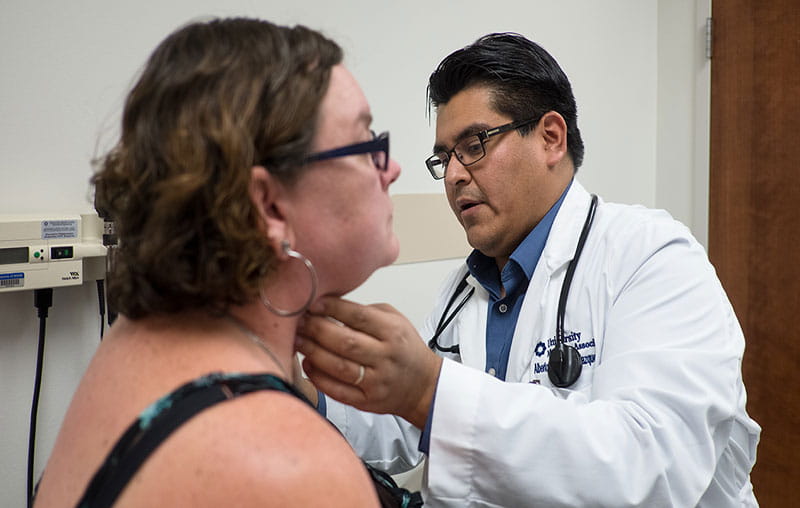Asthma is a common condition for people of all ages, though it often starts in childhood. According to the National Institutes of Health, about 5 million children in the U.S. have asthma.
Asthma is a chronic condition of the lungs triggered by certain irritants, like pollen, dust or animal dander. Genetics may also play a role in whether you develop asthma, as it often runs in families.
Unmanaged asthma may cause your child to miss school or sports.
Dr. Chioma Udemgba, an allergist at the University Health Allergy & Asthma – Babcock clinic, shares more about environmental asthma, seasonal allergy triggers and how you can help your child manage this condition.
What Is Environmental Asthma?
Environmental asthma is a type of asthma that gets triggered when you’re exposed to irritants in the air, like pollen, mold, food, animal fur or smoke. “These factors irritate your airways, causing them to narrow and making it harder to breathe,” said Dr. Udemgba.
Environmental asthma can cause symptoms like:
- Coughing
- Shortness of breath
- Wheezing
- Trouble breathing
- Difficulty catching your breath
Seasonal Allergy Triggers
Environmental asthma can worsen with the changing seasons. Different trees, weeds and grasses bloom throughout the year, introducing a large amount of fine allergen particles to our airways.
Fall Allergens
In South Texas, Fall is the beginning of what some locals call “cedar season” as mountain cedar trees bloom across our region. So-called “cedar fever” causes runny noses, itchy eyes and sore throats from September to December.
Other Fall allergens include:
- Ragweed
- Elm
- Sagebrush
A new study by the University Health Institute for Public Health attributes worsening air quality during this season to an increase in hospital admissions and urgent care visits related to asthma in the Fall.
Spring Allergens
“In Central Texas, Spring can also bring a large quantity of allergy pollen levels into the air,” said Dr. Udemgba. “The yellow dusting you see coating cars is also getting into your airways and onto your skin.” This can cause different allergy symptoms, including sneezing, red eyes, hives and congestion.
Spring allergens include:
- Cedar
- Ash
- Mesquite
- Oak
- Sycamore
- Pecan
Read more from Dr. Udemgba, who shares how you can manage springtime allergies.
Preventative Measures for Asthma
While asthma does not completely go away as your child gets older, the symptoms may lessen with time. It’s important to take preventive measures to manage asthma symptoms and triggers early in order to prevent complications.
Home Management
Dr. Udemgba says there are 10 ways parents and caregivers can help their child manage their asthma:
- Always carry a rescue inhaler.
- Know and reduce your exposure to asthma triggers.
- Take all of your medications as prescribed.
- Wash bedding in hot water every one to two weeks.
- Wash stuffed animals regularly and reduce the number that stay on the bed.
- Use an air purifier with a HEPA filter.
- Limit outdoor time when air pollutants are high.
- Ask your doctor if using a space device is right for your child.
- Keep your car windows rolled up during days with a high pollen count.
- Be sure your child bathes and changes their clothes after spending time outdoors during the peak of the pollen season.
Medication
Your child’s doctor may prescribe medicine to manage environmental or seasonal allergies. These medications may be long-term, like an inhaled steroid medicine taken once or twice daily, or short-term, like an inhaler used to treat symptoms during a flare.
Your child’s doctor will determine the best treatment plan. It may include a combination of home management, frequent office visits, long-term medications and fast-acting rescue medications.
Treatments for Asthma Attacks
Pollutants and irritants in the air can trigger an asthma attack, which is a sudden narrowing and spasming of the airways. When this happens, it can make it very hard to breathe and often causes coughing and wheezing. “This can be scary for anyone, but especially for children,” said Dr. Udemgba.
Knowing environmental triggers and having access to a fast-acting rescue inhaler can ensure you are ready to treat an asthma attack as soon as it happens and keep your child out of the hospital.
What To Do if Your Child Has an Asthma Attack
“If your child is having an asthma attack, give them four puffs of their emergency inhaler (usually albuterol). Wait 5-10 minutes and see if symptoms improve. If they don’t improve, give four more puffs. If symptoms still do not improve after another 5-10 minutes, take the child to the emergency room for treatment.”
Dr. Udemgba says it’s important for caregivers to review the Asthma Action Plan given by your child’s medical provider for the best guidance on treating mild, moderate or severe asthma symptoms. If you do not currently have one, be sure to request one at your next visit.
Short-acting airway relaxant medications, like albuterol, only lasts about four to six hours. Your child’s symptoms may return or worsen. If they do, they may need to start taking long-term asthma medications.
Pediatric Allergy Care at University Health
If at-home management is not improving your child’s symptoms, they may need to see an allergy specialist. Dr. Chioma Udemgba and the allergy team at the Allergy & Asthma Clinic at University Health specialize in environmental allergy testing and asthma management.
Community Resources
Whether you receive care from us or not, you can find community resources related to asthma care through our Institute for Public Health.





